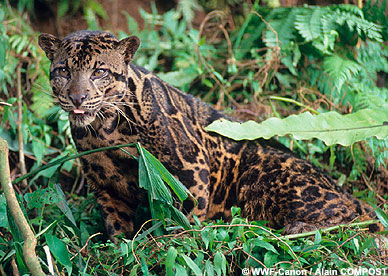It is becoming more and more apparent that if you want to recognize new species, Borneo is the place to be these days (although Malaysian “web footed” sharks don’t count). In this case, it’s not so much that a completely new animal has been found, but that a long suspected need for taxonomic revision has become realized. In the past, the Bornean Clouded Leopard (now known as Neofelis diardi) was assumed to be a subspecies of the Clouded Leopard (Neofelis nebulosa), the Bornean Clouded Leopards inhabiting the Indonesian archipelago and Clouded Leopards inhabiting mainland Asia. I haven’t had the opportunity to see an active Clouded Leopard (the one at the Philadelphia Zoo always seems to be sleeping when I’m around, but that’s what cats do best after all), but this is what they look like;

And now, courtesy of the WWF, is the new Bornean Clouded Leopard;

Bornean clouded leopard (Neofelis diardi)
Kalimantan (Indonesian Borneo), Indonesia.
CREDIT: (c) WWF-Canon / Alain COMPOST
IMAGE No.: 112939
According to the WWF press release, the new species was recognized by use of DNA testing, indicating about 40 differences between the Bornean cats and their mainland relatives, their estimated time of speciation estimated at 1.4 million years ago. Other than the DNA, it is clear merely by looking at the animals that they are of two different species, the Bornean Clouded Leopards being much darker (they almost have a caramel-like coloring) with a double dorsal stripe (not visible in the picture above) and more distinct spots within the larger spots. As Dr. Andrew Kitchener (one author of the paper that determined that there are two species) said, after comparing pelts of animals from the mainland with those of Borneo;
It’s incredible that no one has ever noticed these differences.
While the actual divergence of the Borneo Clouded Leopard occurred 1.4 million years in the past, it still can give us insight into speciation and if we are lucky enough to be around for the centuries (and hopefully, millenia) to come, perhaps providing some clues as to how animals might change after a speciation event. Unfortunately such studies would take much time and effort over many generations, but I hope that by discovering and keeping track of closely related animals in differening ecologies, we can get a better idea about the “tempo and mode” of evolutionary change. Regardless of what we may learn in the future, I for one am ecstatic to know there is another great cat stalking the Bornean jungles, and I hope it will continue to do so far a long time into the future.














[…] 19th 2007, 10:07 am Filed under: Carnivora, Ecology While perhaps not as “sexy” as the Bornean Clouded Leopard, North American wildlife has been making plenty of news lately. Just a few weeks ago it was […]
Hi all. Cool site zawermash Google
Thank.
i think the old one is pretty, yes but id say the new species, with its farker and more pronounced colors n all is way more beautiful ! ! !
I am quite fascinated with the species and its relationships to the other leopards, jaguars etc. I am additionally quite interested in the possiblity the American Cave Lion perhaps being a tiger relative as this would seem a logical radiation for a Siberian animal. Any thoughts would be quite of interest My email is available for such discussion. I also am intererested in the theories regarding the relationship of the clouded leopards to the scimitar cats or the possiblity of an additional recurrence of the trait or adaptation. Cool site. Thx
can I ask a question? what is the ecological niche of a Clouded Leopard?
suck monkey nuts